Deflation Creeping Into The Stock Market
Since the stock market’s high of late May, deflation has begun to creep into the market’s valuations as is obvious when we look at the NYSE’s 52Wk Highs and Lows. From May 28th to June 24th, the NYSE 52Wk High – 52Wk Low ratio declined from +15% to -17%. Such a large decline in only one month must be telling us something; most likely that the smart money is locking in their profits from the past year.
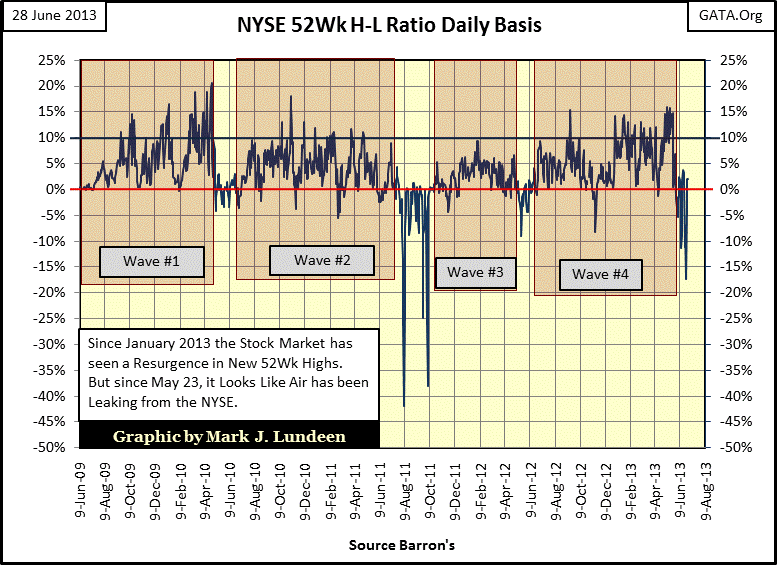
A more compelling chart to illustrate my point that the stock market may very well have passed an important high-point is seen with the Dow Jones Total Market Groups’ (DJTMG) all-time highs. In Barron’s May 20th issue, 40 of 74 stock groups saw a new ALL-TIME HIGH. That is a lot of new all-time highs! Nothing similar to this has happened since 1998 when Alan Greenspan was “injecting” go-juice into the stock market.
So, the major stock indexes may yet see new all-time highs in the coming year. But as was the case after the DJTMG’s peak on 16 June 1997, I expect to see fewer market sectors join the party. In other words, after a broad-based peak in all-time highs in the general market the major indexes may continue making new all-time highs. But it will become harder finding winners in the general stock market as investors have to be in the right stock groups to obtain capital gains. Many stock groups will begin their bear market ahead of the Dow Jones and S&P by months or years. That is just how bull markets end, and bear markets begin.
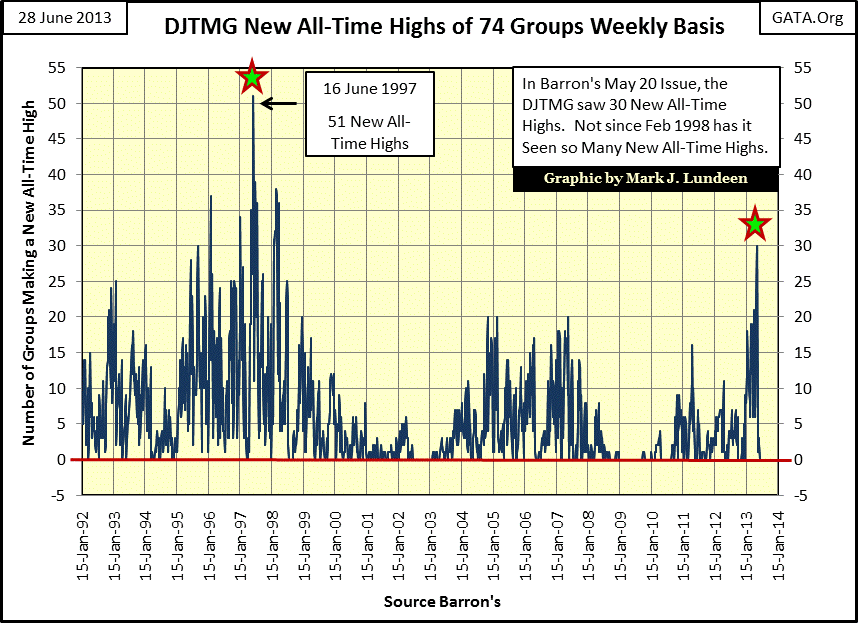
Is the bull market in stocks over? Well, you know I don’t like the stock market and haven’t for a long time, because currently most of the demand for what is being bought and sold at the NYSE is political, and funded by the Federal Reserve. And it’s not just me saying bad things about the stock and bond markets. Last April the Milken Institute’s Global Conference for 2013 offered some words of wisdom for everyone:
“Run, don’t walk from bonds.”
- Joshua Harris, the co-founder and chief investment officer of Apollo Global Management, April 2013
Mr. Harris really had a timely call on bonds two months ago, but he sounds rather optimistic compared to his colleague Leon Black:
“Over the last 15 months we've been a net seller. "We're selling everything in our portfolio that's not nailed down, and if it is nailed down, we're refinancing it. It's almost biblical. There's a time to reap and a time to sow. We're harvesting."
- Leon Black of Apollo Global Management, April 2013
Amen to that!
No one is denying that the past year has been a great one for the stock market. From May 2012 to May 2013 the stock market had a great year, but my thinking is that May 2013 may prove to be a bull market peak. Eventually, even Doctor Bernanke will learn that bull markets don’t last forever. Here’s a table showing the performance of the Dow Jones Total Market Groups (DJTMG) in terms of their 52 Wk highs and lows from Barron’s 20 May 2013 issues. All data is based on weekly closing prices.
Looking at #1 (Airlines) for Barron’s May 20th issue, we see under the GREEN 52Wk High tab a 0.00%, which indicates that Airlines made a 52Wk high in this issue of Barron’s, as did 58 other indexes in the DJTMG – Wow! The BLUE 52Wk Low tab tells us how far Airlines have risen from their 52Wk Low: 85.98%, a huge 52Wk gain. Not passing out free peanuts to their coach passengers really improved their market performance! How the other 57 groups became so popular that they found their group prices at 52Wk highs in late May I haven’t a clue, but I believe late May will prove to be a top in the stock market.
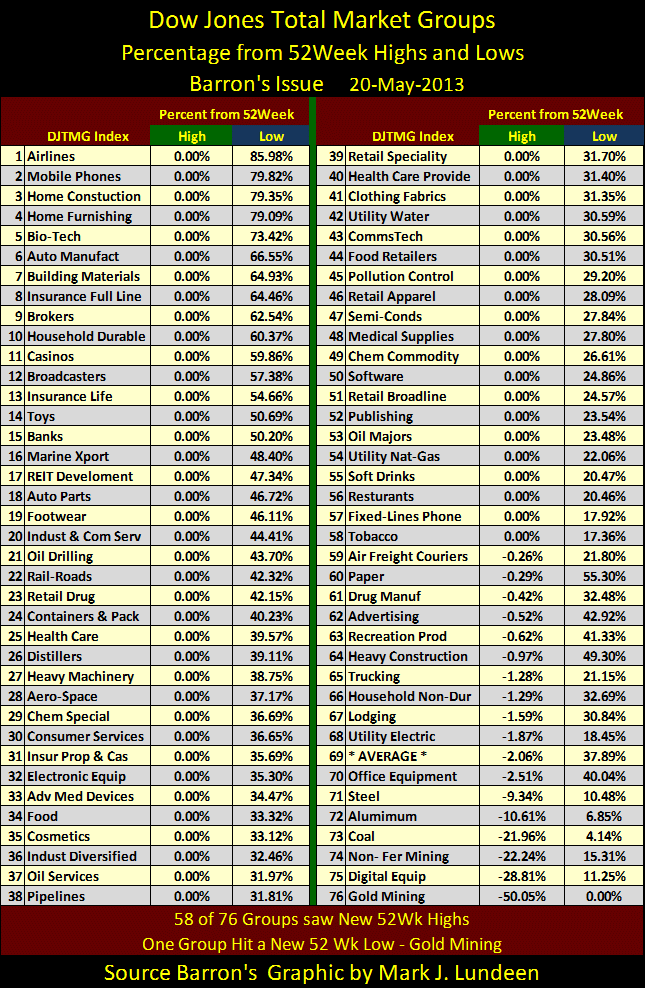
The Airlines aren’t the only stock group that saw a phenomenal year in Barron’s May 20th issue; 29 of the 74 groups were up over 40% in the past 52weeks. But the question is how likely is it that a year from now, investors will see similar gains from the stock market? I think it’s very unlikely, unless Doctor Bernanke or his replacement increases their QE to some grotesque level; which they just may.
The table above is from a month ago. With its 58 new 52Wk Highs, it is most likely the high water mark for the post March 2009 “bull market.” I personally believe the current market advance will prove to be a contrived Dead Cat Bounce from the March 2009 lows, levitated with a few trillion dollars of monetary inflation from the Federal Reserve. The Dow Jones may once again rise up to new all-time highs, but I doubt we will see 58 of the 74 groups in the DJTMG making new 52Wk highs for a long time to come. It really does make sense to begin looking for reasons to sell the market, and stay away for the next year.
Next is the table with the latest data from Barron’s. Only two 52Wk highs from last week, and two new 52Wk lows: Gold Mining and Coal, both are currently politically incorrect stock groups in Washington and New York. But the numbers to look at are under the Green 52Wk high tab. Compare them to the numbers from the May 20th table above.
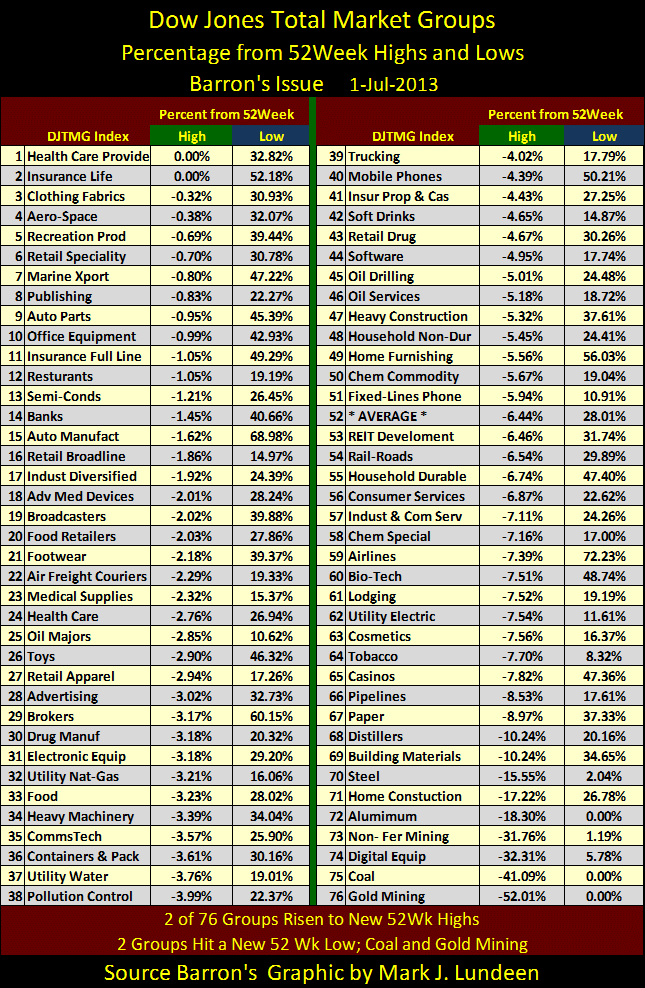
With the Dow Jones down 2.90% from it all-time high of May 20th, look at how far the other groups have fallen that were at new 52Wk highs just six weeks ago. Below #26 (Toys), all the groups have fallen more than the Dow Jones, some by a huge amount! Look at Home Construction in the July 1st table, it’s at #71 with a 17% decline from its last 52Wk high. Guess when Home Construction saw its last 52Wk high? In Barron’s May 20th issue, in the #3 spot! That is a huge decline in an economic sector that economists have such high expectations for pulling the rest of the economy out of the dumps.
To show you how much things can change over a few years, here is the table containing data from the 09 March 2009 credit crisis low; it’s the mirror image of the May 20th data, with no new 52Wk Highs and 56 new 52Wk Lows. The best performing DJTMG group was Water Utilities (#1), which was 20% below its 52Wk high. Now look at Gold Mining (#8); it may have been down 33% from its 52Wk High, but it was up 62% from its 52Wk Low. Non-Ferris Mining (#61) is also interesting. Like gold mining, the other miners bottomed in October 2008 under suspicious circumstances. When the other groups hit their bottoms five months later in March 2009, the gold and copper miners were far ahead of the pack.
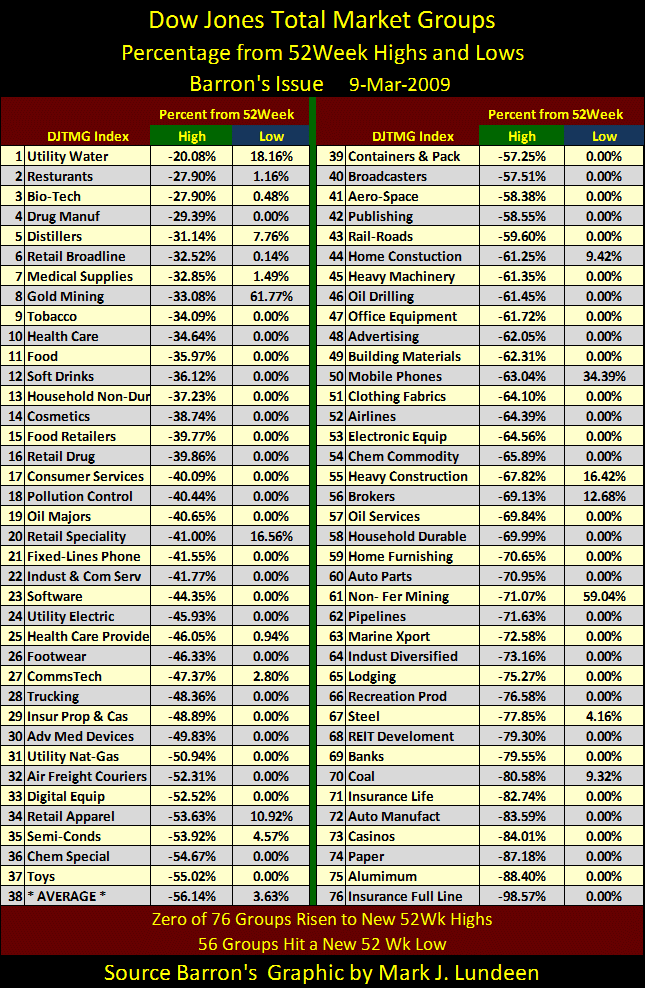
The table above for 09 March 2009 is technically important. It’s the point where the credit crisis bear market was terminated by bankers, politicians, and academics; three groups of people who have no love for the free market. These people believe they are the smartest people in any room they sit in, and are above the laws of God and man in their mission to save their banking system from the hobgoblins of deflation. They also feel entitled to create money from nothing, and to do what they damn well please in the market place using monetary inflation to manipulate market valuations, as they did in early 2009 when they thwarted Mr Bear in his mission to take stock prices far below what we see in the table above.
So how far should these indexes have fallen if “the smartest people in the room” hadn’t butted in? I don’t know, but if you believe in the old Dow Jones dividend valuation model where the bull market continues until the Dow Jones dividend declines to a 3% yield, and bear markets continue until they see a Dow Jones dividend go above a 6% yield, the stock market has been overvalued since Alan Greenspan became Fed Chairman in 1987. Look at the chart below to see how overvalued the stock market has been for decades. After Greenspan came to the Federal Reserve in August 1987, the stock market operated very differently than it had for the six decades before his arrival (1925-1987).
By the time Easy Alan Greenspan began wondering about “irrational exuberance” in the stock market (December 1996), the Dow Jones’s dividend yield was but a month away from slipping below 2%, something that has never happened in the history of the NYSE. The Dow’s ultimate low yield was a pathetic 1.30%, seen on 14 January 2000 as the Dow Jones saw its 1982-2000 top of 11,722. Before Alan Greenspan, no Fed Chairman attempted to directly manage stock market valuations. Since Alan Greenspan became Federal Reserve Chairman in 1987, preventing bear markets from taking place (deflation) has been a stated goal of the Federal Reserve, as is obvious in the Dow Jones Dividend Yield chart below.
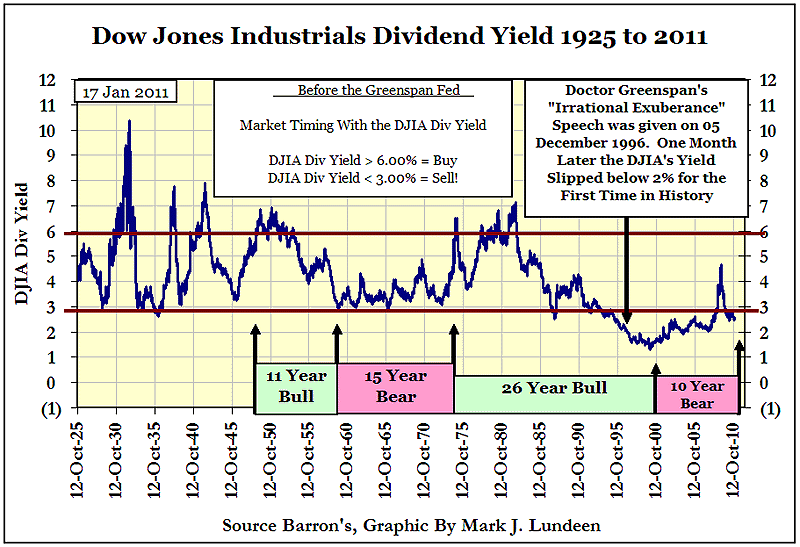
At the March 2009 bottom, the Dow Jones’ dividend yield increased to only 4.74% as its valuation declined a whopping -53.78% from its high of October 2007. This decline is #2 Dow Jones bear market since 1885 and the Dow’s dividend yield didn’t even break above 5%. By the way, I’m still counting the weeks for our bear market; it’s been 298 weeks since it saw its top in October 2007. But the Dow went on to a new all-time high this year, so you may think this inaccurate. If so, the Oct 2007 - March 09 bear market lasted 73 weeks.
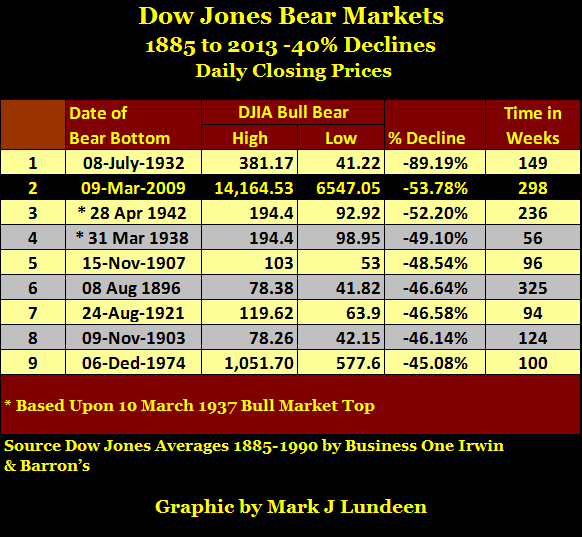
A 4.74% is far below 6% when it comes to dividend yields and their impact on market valuations. Four years ago, what would have happened to the Dow Jones valuation had its dividend yield increased to 6% as its dividend cash payment decline from $310 to $200 (35% decline). Both circumstanced well within historical standards of past bear markets since 1925. The table below provides the answer with mathematical precision – Dow Jones at 3333, or a final bear market decline of 76.46%. That would be a depression bottom. And if the Dow Jones had declined by 76% sometime in 2009-10, most of the DJTMG would have done much worse than the Dow Jones, far below where we see them on 09 March 2009.
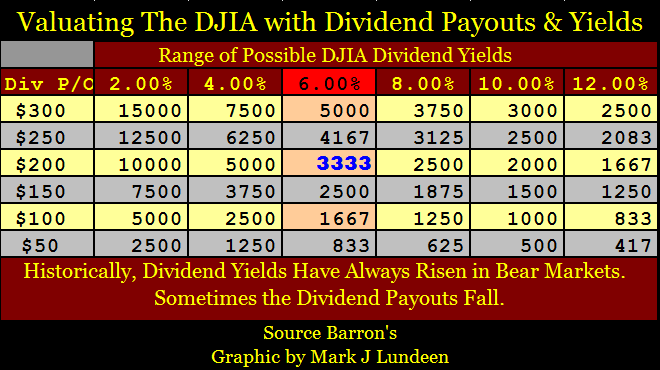
If Congress hadn’t given a monetary “bazooka” to Treasury Secretary Paulson and Fed Chairman Bernanke in October 2008, we would have seen many more 80% & 90% declines in the DJTMG before Mr Bear was finished with the bulls. After two decades of Easy Alan Greenspan and Bubbles Bernanke’s inflationary-market machinations, Mr. Bear had much to do in 2008-09, as he still does today. I expect the next phase of the 2007 – 201? Bear market to deeper than what we saw in March 2009 as next time Mr Bear will overwhelm the best efforts of Washington and Wall Street.
















